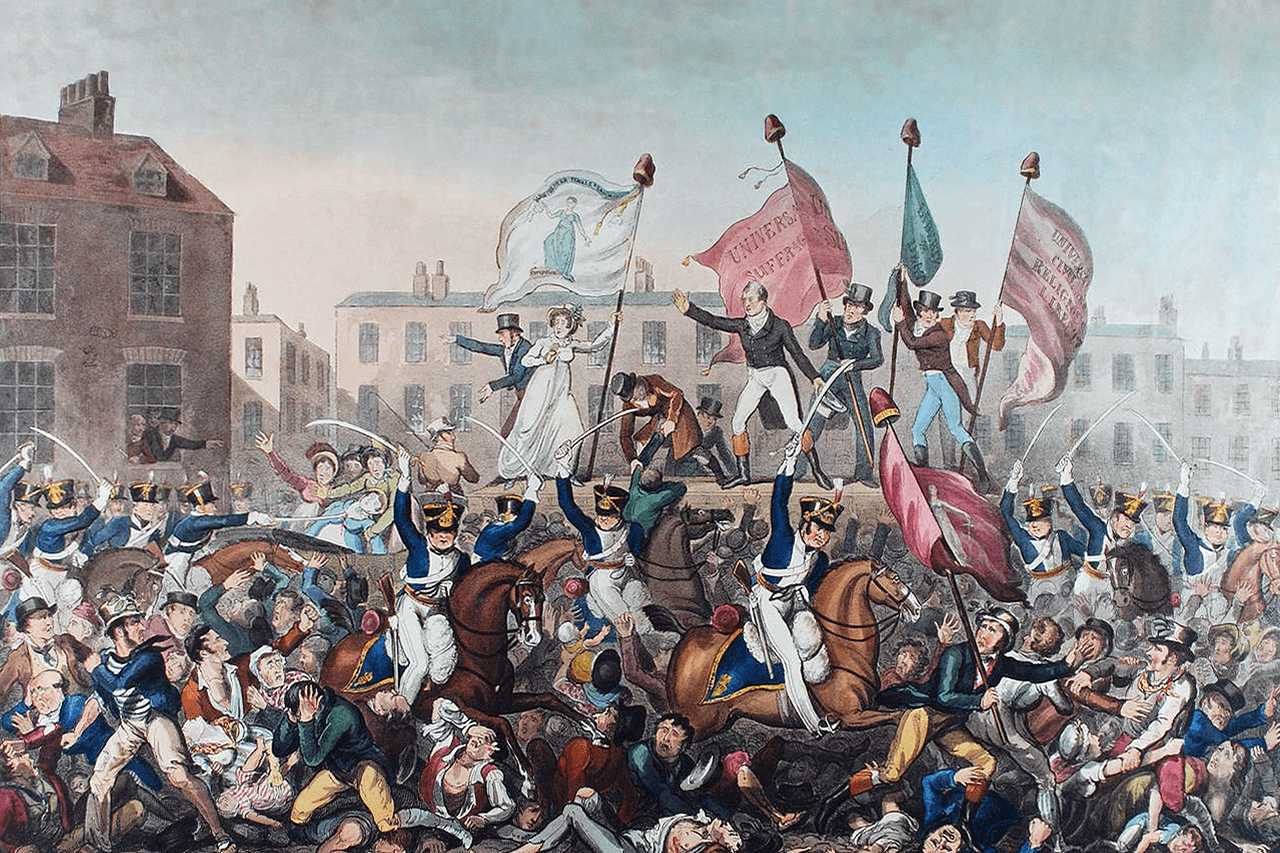
Today in Labor History August 16, 1819: Police attacked unemployed workers demonstrating in St. Peter’s Field, Manchester, England. When the cavalry charged, at least 18 people died and over 600 were injured.
The event became know as the Peterloo Massacre, named for the Battle of Waterloo, where many of the massacre victims had fought just four years earlier. Following the Napoleonic Wars there was an acute economic slump, terrible unemployment and crop failures, all worsened by the Corn Laws, which kept bread prices high. Only 11% of adult males had the vote. Radical reformers tried to mobilize the masses to force the government to back down. The movement was particularly strong in the north-west, where the Manchester Patriotic Union organized the mass rally for Peter’s Field. As soon as the meeting began, local magistrates tried to arrest working class radical, Henry Hunt, and several others. Hunt inspired the Chartist movement, which came shortly after Peterloo.
John Lees, who later died from wounds he received at the massacre, had been present at the Battle of Waterloo. Before his death, he said that he had never been in such danger as at Peterloo: “At Waterloo there was man to man but there it was downright murder.” In the wake of the massacre, the government passed the Six Acts, to suppress any further attempts at radical reform. The event also led indirectly to the founding of the Manchester Guardian newspaper.
Peterloo in Film and Fiction
Percy Bysshe Shelley wrote about the massacre in his poem, “The Masque of Anarchy.” The authorities censored it until 1832, ten years after his death. Mike Leigh’s 2018 film Peterloo is an excellent portrayal of the massacre, and the events leading up to it. Many writers have written novels about Peterloo, including the relatively recent “Song of Peterloo,” by Carolyn O’Brien, and “All the People,” Jeff Kaye. However, perhaps the most important is Isabella Banks‘s 1876 novel, “The Manchester Man,” since she was there when it happened and included testimonies from people who were involved.
1920s
Today in Labor History August 16, 1929: The 1929 Palestine riots broke out in Mandatory Palestine between Arabs and Jews. In total, 133 Jews and 116 Arabs died in the riots. The conflict began when several hundred members of a right-wing group Jewish youth group marched to the Western Wall shouting “the Wall is ours.” Rumors circulated among the Arabs that the procession carried weapons and had attacked local residents and cursed the name of the Prophet Muhammad.
The following day, an Arab stabbed a 17-year-old Jew. A Jewish mob attacked the cops who were trying to arrest the Arab suspect. They also attacked and burned neighboring Arab tents and shacks. Over the next four days, there were another 12 attacks by Jews on Arabs and seven attacks by Arabs on Jews.
1930s
Today in Labor History August 16, 1933: The anti-Semitic Christie Pits riot took place in Toronto, Canada. At the time, Toronto’s Jewish community was predominantly poor and working-class. During the summer, they would going to the predominantly Anglo Beaches to swim. Some of the locals formed a “Swastika Club” and openly displayed the Nazi symbol to intimidate the Jews. The riot broke out after a baseball game when people displayed a blanket with a large swastika painted on it. A number of Jewish and Italian youth rushed the Swastika sign to destroy it, resulting in a melee with fists and clubs. A mob of more than 10,000 joined in, amidst cries of Heil Hitler. Miraculously, no one died. However, scores were injured. Many required medical and hospital attention.
The incident was depicted in two graphic novels: “Christie Pits” (2019) written by Jamie Michaels and illustrated by Doug Fedrau, and “The Good Fight” (2021) by Ted Staunton and Josh Rosen.
August 16, 1973 – A 60-year-old United Farm Workers (UFW) member, Juan de la Cruz, was shot to death by a strike breaker during the UFW’s a second grape boycott, in opposition to the Teamster’s sweetheart deals with the California growers.
2000s
Today in Labor History August 16, 2012: South African police fatally shot 34 miners and wounded 78 more during a strike.




Pingback: Today in Labor History February 23 - Michael Dunn